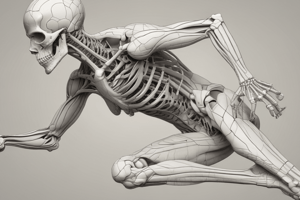Podcast
Questions and Answers
What is the branch of science that examines the forces acting on objects and the movements that these forces create on the object?
What is the branch of science that examines the forces acting on objects and the movements that these forces create on the object?
- Kinesiology
- Biomechanics (correct)
- Neurophysiology
- Anatomy
What determines the purposeful movements of humans according to the text?
What determines the purposeful movements of humans according to the text?
- Neuromuscular Physiology alone
- Biomechanical Anatomy alone
- External forces exceed internal forces
- Interaction between muscle strength and external forces (correct)
Which field of study focuses on the laws of motion as they apply to bodies at rest or in motion?
Which field of study focuses on the laws of motion as they apply to bodies at rest or in motion?
- Biomechanical Anatomy
- Kinesiology
- Neuromuscular Physiology
- Mechanics (correct)
Which term refers to the study of the relationship between nerves and muscles regarding movement?
Which term refers to the study of the relationship between nerves and muscles regarding movement?
What does Anatomy primarily focus on concerning human movement?
What does Anatomy primarily focus on concerning human movement?
Which law of motion explains the change in moments of bodies?
Which law of motion explains the change in moments of bodies?
In human movement, when do movements occur within the body according to the text?
In human movement, when do movements occur within the body according to the text?
According to Newton's Third Law, what happens when a force is applied to an object?
According to Newton's Third Law, what happens when a force is applied to an object?
Which type of joint allows for circumduction movement?
Which type of joint allows for circumduction movement?
Which joint group is characterized by non-moveable joints?
Which joint group is characterized by non-moveable joints?
Which plane divides the body into right and left halves?
Which plane divides the body into right and left halves?
What is the primary movement that occurs around the transverse axis?
What is the primary movement that occurs around the transverse axis?
What type of joint allows for flexion-extension and abduction-adduction movements?
What type of joint allows for flexion-extension and abduction-adduction movements?
What prevents joint faces from moving away from each other?
What prevents joint faces from moving away from each other?
What is muscle tone?
What is muscle tone?
What proteins are involved in muscle contractions?
What proteins are involved in muscle contractions?
Which muscle type contains only myosin and actin?
Which muscle type contains only myosin and actin?
What happens when the nerve impulse reaches the sarcoplasmatic reticle membrane?
What happens when the nerve impulse reaches the sarcoplasmatic reticle membrane?
Flashcards are hidden until you start studying
Study Notes
Kinesiology
- Kinesiology is the science that examines the movements created by any force and the forces that cause the movements within the mechanical laws and compares them with pathological conditions.
Mechanics
- Mechanics is a branch of science that examines the forces acting on objects and the movements that these forces create on the object graphically and analytically.
- It is a branch of Physics and Engineering.
- It is concerned with forces, bodies, and motion.
- The laws of mechanics apply to bodies at rest or in motion.
Biomechanics
- Biomechanics is the use of the laws of mechanics for the study of human structure/movement.
Movement and Forces
- The purposeful movements of humans result from the interaction between muscle strength and external forces.
- Movement occurs in the body when the internal forces are greater than the external forces.
- Force (F) = mass (m) x acceleration (a)
- Force (F) = Weight (W) x acceleration (a)
- Force (F) = Weight (W) x (Vs - Vo) / time (t)
Newton's Laws
- Newton's Law shows the change in moments of bodies.
- Newton's Law III (action-reaction principle): When a force is applied to an object, a reaction force equal to but opposite to the force applied on that object arises.
Anatomical Position and Axes
- Anatomical position is the position of the body when standing upright with feet together and arms at the sides.
- Axes:
- Transvers axis: flexion and extension
- Vertical axis: internal and external rotation
- Sagittal axis: abduction and adduction
Planes
- Horizontal plane
- Median plane
- Sagittal plane
- Coronal (frontal) plane
Joints
- Joint Groups:
- Articulatio Fibrosa (synarthrosis): non-moveable joints
- Articulatio Cartilaginea (amphiarthrosis): semi-moveable joints
- Articulatio Synovialis (diarthrosis): moveable joints
- What should be present in a synovial joint:
- Articular cartilage
- Joint capsule
- Synovial fluid
- Ligaments
- Joint types:
- Roller type joint: transvers axis / flexion-extension
- Cylinder shaped joint: vertical axis / internal-external rotation
- Elliptical shaped joint: transvers axis and sagital axis / flexion-extension and abduction adduction
- Saddle shaped joint: transvers axis and sagital axis / flexion-extension and abduction adduction
- Sphere shaped joint: transvers, sagital, vertical and secondary axes / flexion-extension, abduction adduction, IR-ER, circumduction
Factors Preventing Joint Faces from Moving Away
- Negative air pressure in the joint space (Vacuum effect)
- Joint capsule and joint ligaments
- Muscles and tendons surrounding the joint
- Shape of joint faces
Muscles
- Tonus: muscle tone, the continuous and passive partial contraction of the muscles.
- Hypertonsity: abnormally increased muscle tone
- Hypotonsity: abnormally decreased muscle tone
- Spasticity: a state of increased muscle tone resulting in stiffness and spasm
- Muscle structure:
- Actin
- Myosin (which makes up 50% of the total protein amount)
- Tropomyosin
- Troponin
- Smooth muscles contain only myosin and actin.
Studying That Suits You
Use AI to generate personalized quizzes and flashcards to suit your learning preferences.




